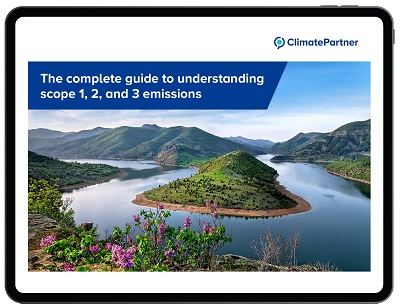
What is carbon accounting?
Carbon accounting is the process of quantifying and tracking the greenhouse gas (GHG) emissions from an organisation and its products. This sets the basis for organisations to understand their climate impact and set goals to reduce their emissions.
Carbon accounting methods
At the core of carbon accounting are methods and standards that guide how emissions are measured and reported.
The most widely adopted standard for carbon accounting is the GHG Protocol, which categorises emissions in three scopes:
- Scope 1: Comprises direct emissions from owned or controlled sources, such as company vehicles and industrial processes.
- Scope 2: Includes indirect emissions from the generation of purchased electricity, steam, heating, and cooling.
- Scope 3: Encompasses all other indirect emissions that occur in a company’s value chain, including those from suppliers and product end-use.
Whether calculating a corporate (CCF) or product carbon footprint (PCF), companies should use a carbon accounting tool to track emissions. This enables them to assess current GHG levels, track emissions and set future reduction targets.
Carbon accounting software
Carbon accounting software helps businesses calculate, track, and report their GHG emissions. By collecting data on activities, the software then uses emission factors to calculate the amount of carbon produced based on this data, categorising the results into three scopes.
The software generates reports to track progress and ensure compliance with regulations, helping businesses set and monitor emissions reduction targets.
Carbon accounting solutions example
A manufacturing firm uses carbon accounting software to track and quantify its carbon emissions across different scopes:
- Scope 1 (direct emissions): The software measures direct emissions from company-owned machinery and vehicles, such as fuel combustion in production equipment or on-site generators. This helps the firm monitor efficiency and identify opportunities to reduce emissions, such as upgrading to energy-efficient machinery or optimising fuel use.
- Scope 2 (indirect emissions): The company uses the software to track emissions from purchased electricity, ensuring accurate reporting of renewable energy use. If the company invests in solar panels or purchases renewable energy credits (RECs), the software can account for these reductions and incorporate them in sustainability reports.
- Scope 3 (other indirect emissions): The software analyses emissions from the supply chain, including the carbon footprint of purchased raw materials, logistics, and even employee commuting. Advanced solutions can integrate with supplier data to provide more accurate insights, enabling the company to choose lower-carbon materials or optimise shipping routes to minimise emissions.
SBTi and carbon accounting
The Science Based Targets initiative (SBTi) provides a framework for companies to set GHG reduction targets aligned with climate science. It guides carbon accounting by promoting adherence to the GHG Protocol, ensuring accurate emissions measurement across all scopes.
The SBTi also emphasizes transparency, requiring public disclosure of emissions and progress. Companies are encouraged to continuously refine science-based targets and accounting practices to stay aligned with evolving climate science and best practices.
The Carbon Footprint Calculator
ClimatePartner uses carbon accounting software, called the Carbon Footprint Calculator, to help companies measure, manage, and report their emissions:
- CCF compliant with CSRD and FLAG: provides all CSRD E-1 5 and 6 data points and FLAG splits for SBTi.
- Supports both: activity-based data entries for detailed calculation breakdowns and a spend-based approach for easy-to-implement emission screenings.
- Integration of supplier-specific data.
- Hybrid approach in data collection: consultants ensure data is complete, accurate, and comparable across all entities.
- Scope 1, 2, and 3 data collection at country, entity, and site level for all applicable users
- AI-powered assistance for mapping emission factors and closing data gaps
- Quality Management Process for Limited Assurance and expanded auditing support
